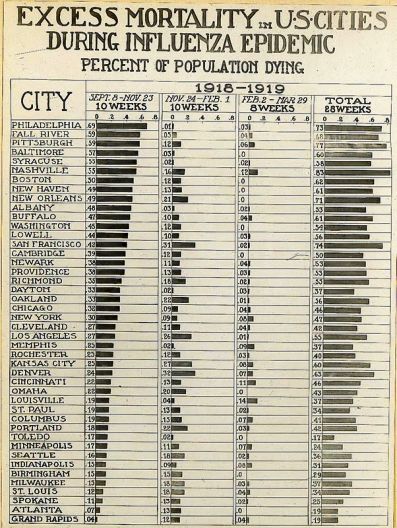1918 flu pandemic ravaged W.Va. link/
mõned lõigud pikemast jutust:
An October 1918 letter written by a 16-year-old boy from Iowa paints a grim picture of Kanawha County. The Sioux Falls farm boy had traveled to Nitro to look for work. Upon entering the valley, his first sight was the unloading of boxes of soldiers' bodies at the Nitro train station. They hadn't been killed in the line of duty, but by the flu.
"Olive (a cousin) stayed with us most of the time as the rest were down with the flu," Spencer wrote. "We had a little burn side stove with a little flat rim around the top of it. Mom kept onions roasted on it all the time, and (we) would eat them. Mom would give us a little hot toddy to drink. It was made with a little whisky, water and sugar. We were told that would keep down the flu. It must have worked because the three of us didn't have it. There were a lot of people sick...and whole families died."
Fred and Molly Bennett had one of the most harrowing stories. In October 1918 their only child, a daughter, died from the flu. In April 1919, Molly gave birth to another baby, but Molly died two days later from complications of the sickness. In the following weeks Molly's sister and brother-in-law also died, leaving five children behind. Those children were sent to an orphanage, along with Molly's tiny newborn, who was delivered there in a cigar box by her father, Fred, the only other surviving member of the entire family. Heartbroken over the death of his wife and oldest daughter, and assuming his tiny newborn also would perish, Fred Bennett left Curtin and never returned.
Day-to-day life in 1919 became unrecognizable. Schools ground to a halt; markets, stores and banks shut down because there was no one to run them; and families barricaded themselves inside their homes, sometimes with little food and no supplies, in a vain attempt to keep away from the virus. As doctors began coming down with the same illness afflicting their patients, even rudimentary medical care was hard to come by.
Records from the West Virginia School for the Deaf and Blind in Romney reveal a two-month flu outbreak in the fall of 1918 that almost spelled disaster for the entire town. In the end, four students and teachers at the school died, but more than 200 became critically ill. "The school hospital and dormitories were filled with the sick," records said. "Four nurses were secured, but they soon became patients. The nursing fell upon the remaining teachers and officers and a number of voluntary residents of Romney."
